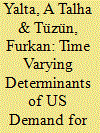| Srl | Item |
| 1 |
ID:
187362


|
|
|
|
|
| Summary/Abstract |
We examine the determinants of military spending of the six countries in the Gulf Region by using a partial adjustment model in a system setting estimated with the three-stage least squares (3SLS) method. Our model takes into consideration the institutional inertia as well as intercountry correlations, both observed and unobserved. In addition to economic variables, we also consider a series of strategic variables to shed light on various issues such as free riding and spill-in effects. Our findings based on annual data between 1980 and 2016 indicate that the military expenditures are influenced by both economic and strategic factors with a high degree of heterogeneity across different countries. Our results also show that the GCC member countries do not free ride on each others’ military expenditures. In addition, the US military presence is an important determinant of defense spending in the region.
|
|
|
|
|
|
|
|
|
|
|
|
|
|
|
|
| 2 |
ID:
111371


|
|
|
|
|
| Publication |
2012.
|
| Summary/Abstract |
In conventional causality testing based on asymptotic distribution theory, there is a high risk of wrongly rejecting the true null of no causality especially when the sample size is as small as typically seen in the literature. In this study, we offer a formal diagnosis of the existing contradictory results on the causal relationship between energy consumption and real GDP. We also employ a time series oriented advanced data generation process to perform simulation based inference for the People's Republic of China. Our study covers the 1971-2007 period and considers five different aggregated and disaggregated energy consumption measures as well as three different lag orders in both a bivariate as well as a multivariate frameworks. Our maximum entropy bootstrap based analysis, which avoids pretest biases and is also robust to Type I errors, supports the neutrality hypothesis in 53 out of the total of 60 model estimations. The strong results show that coarse aggregate data has a limited potential to observe the complex causal linkages between energy consumption and economic growth. Future policy oriented research on this nexus requires more focused analyses based on sectoral and provincial data.
|
|
|
|
|
|
|
|
|
|
|
|
|
|
|
|
| 3 |
ID:
182548


|
|
|
|
|
| Summary/Abstract |
We adopt the maximum entropy bootstrap methodology in a rolling window framework in order to investigate the time varying determinants of the US demand for defense spending. Our results based on annual data between 1967 and 2018 show that the US defense demand is mainly driven by lagged military burden, economic growth, GDP share of non-military government spending, election cycle, relative costliness of defense as well as the Russian and the Chinese military burdens. Moreover, the signs and the magnitude of the coefficients show significant variations throughout the sample period. The results also provide a strong evidence of the rising rivalry between the US and China, reflecting the developments in the world economy and the global military arena in the last two decades.
|
|
|
|
|
|
|
|
|
|
|
|
|
|
|
|